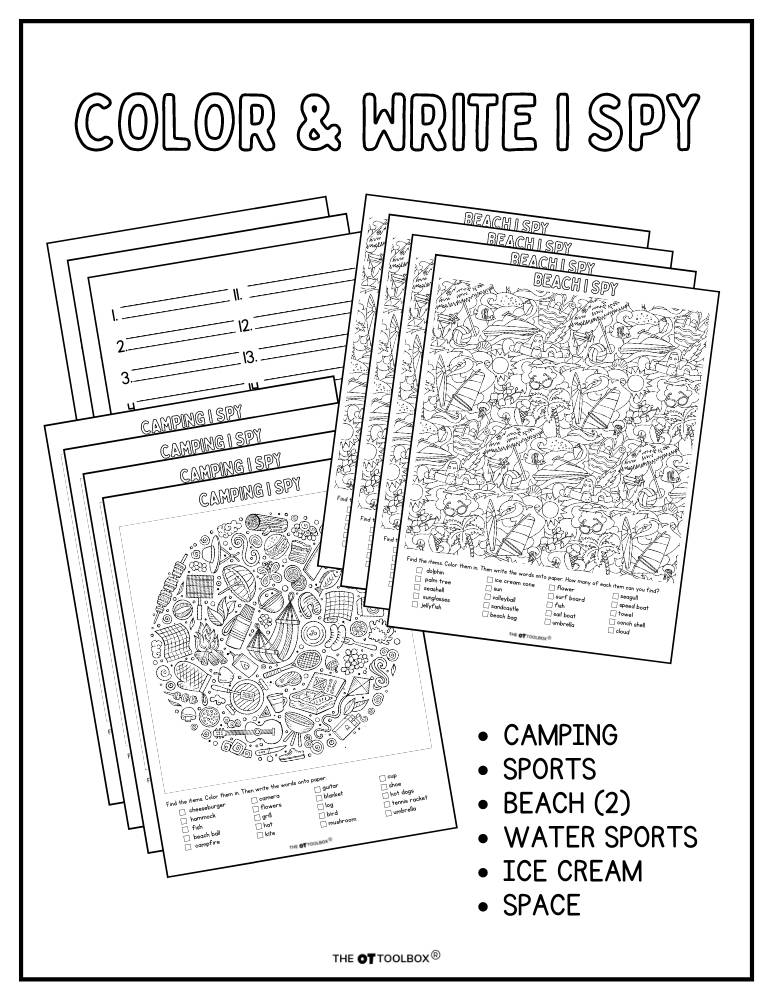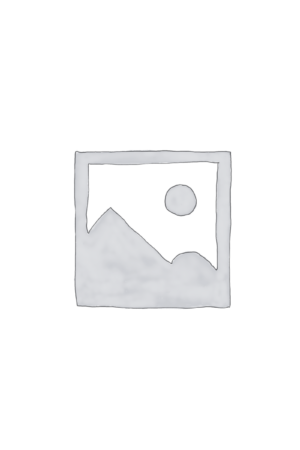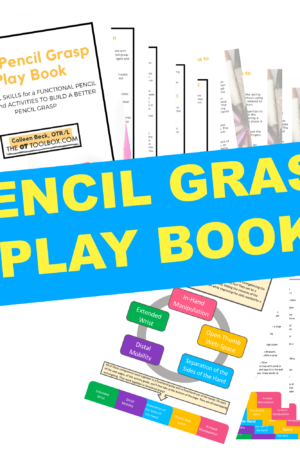Color and Write I Spy
$3.00
Learners of all ages can benefit from a game of I Spy. Add a paper version with a coloring/writing activity, and a well rounded plan is born!
This set of printable Color and Write I Spy pages have enough variety to delight everyone. Included are camping, water sports, two beach pages, ice cream, and space themed pages. Also included are handwriting sheets for copying search words. By coloring, searching, and writing, learners work on visual perception, fine motor skills, dexterity, strength, executive function, bilateral coordination, and social/behavioral skills.
The Color and Write I Spy set is versatile enough to be used in many different ways, to adapt it to the needs of many different groups of learners.
Description
This digital file is a set of coloring and handwriting I Spy activities. This set includes six different themed I spy pages, along with four types of writing pages for varied levels of learners. With this set of printable PDF pages, a multi-level activity can be hatched that will even motivate some of your reluctant students.
Why are learners reluctant to participate in visual motor tasks?
Everyone wants to win. They want to get it right the first time and be the best. It is difficult to have the motivation to be the best, but not the ability. After failing a few times, learners give up. They can often see what needs to be done and their brain makes sense of it, but their body does not cooperate. These learners often gravitate to tasks that have either no right answer, like scribbling on a paper, or just one way to do something, like a puzzle or counting objects (students who like numbers start to dislike math because of the writing involved).
While visual perceptual tasks only have one right answer, they can also be frustrating. Learners who want to get the right answer every time can easily become discouraged by trying their best, and not being able to find the right answer. With practice, visual perceptual difficulties and handwriting can be helped.
With activities that contain different tasks, like this Color and Write I Spy challenge, there is a chance your learner may be great at some part of it. For learners who are not great at any of the skills needed, it might be easiest to start by isolating one or two skills. Work on perception by pointing at the items rather than writing and coloring them. Project this onto the board and work together as a group, so learners who are struggling do not feel singled out.
Other ways to modify this Color and Write I Spy Printable
- Lowest level learners can point to the pictures as they find them
- Middle level learners can find the items and color them
- Higher level learners can find the item, color it, and write the words on the lined pages
- Make the task more challenging by removing the sight word clues. See how many items your learner can find and spell without clues
- Laminate the page for reusability. This saves on resources, and many learners love to write with markers! Note: while some children love wipe off sheets, others become upset that they can not take their work with them. One option is to take photos of the complete work to send home
- Make this part of a larger lesson plan including gross motor, sensory, social, executive function, or other fine motor skills
- Print in black and white or on colored paper for different levels of visual difficulty
- Talk about the items, describe their characteristics, and give context clues to help your learner understand where a certain item is hidden
- Project this page onto a smart board for students to come to the board and write in big letters
- More or less prompting may be needed to grade the activity to make it easier or harder
- Work in pairs or in a small group to address problem solving, turn taking, and negotiation skills
- Have students write on a slant board, lying prone on the floor with the page in front to build shoulder stability, or supine with the page taped under the table
Skills Addressed:
- Hand strength and dexterity – staying on the lines builds hand strength and develops muscle control
- Visual motor skills –Combining what is seen visually and what is written motorically. It takes coordination to be able to translate information from visual input to motor output. Coloring, drawing, counting, cutting, and tracing are some visual motor skills.
- Visual Perception – Figure ground, parts to whole, and visual closure are important to academic development. Six key perceptual skills are addressed in this I spy worksheet
- Visual Attention: The ability to focus on important visual information and filter out unimportant background information.
- Visual Discrimination: The ability to determine differences or similarities in objects based on size, color, shape, etc
- Visual Memory: The ability to recall visual traits of a form or object
- Visual Figure Ground: The ability to locate something in a busy background
- Visual Form Constancy: The ability to know that a form or shape is the same, even if it has been made smaller/larger or has been turned around
- Visual Closure: The ability to recognize a form or object when part of the picture is missing
- Many adults are unable to complete puzzles or find missing objects because they can not perceive parts to a whole. They only see the forest, not the individual trees.
- Sequencing – will your learner do the words in order? Will they look for the easy and/or obvious answers first? Will they go in a haphazard pattern all over the page?
- Proprioception – pressure on paper, grip on pencil
- Social/Executive Function – Following directions, turn taking, task completion, orienting to details, neatness, multi-tasking, attending to task, and impulse control
- Handwriting: Letter formation – correctly forming the letters top to bottom. Letter sizing – correctly fitting the letters into the size boxes. Spacing, line placement, directionality, and spelling are also addressed
- Copying – copying words from a model, transferring the letters from one place to another
- Fine motor strengthening, hand development, and grasping pattern
- Bilateral coordination – remembering to use their “helper hand” to hold the paper while writing. Using one hand for a dominant hand instead of switching back and forth is encouraged once a child is in grade school or demonstrates a significant strength in one or the other.
- Strength – core strength, shoulder and wrist stability, head control, balance, and hand strength are all needed for upright sitting posture and writing tasks.
- Following directions, attention to detail, turn taking, waiting, social skills, compliance, behavior, and work tolerance
This is a digital file.






